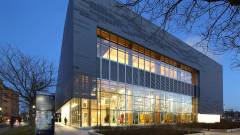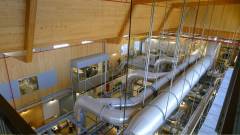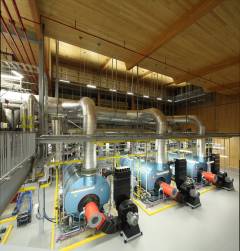Client: The University of British Columbia
Year: 2010 – 2016
Project Highlights
- GHG emissions reduced by 34%
- Floor Area: 7.6 million ft²
- Peak Load: 184.3 MMBH
- Annual Energy 416,281 MMBtu
Contributing to UBC’s Climate Action Plan with a state-of-the-art facility.
FVB completed two detailed feasibility studies (in 2011 and 2012) for conversion of the University of British Columbia (UBC) District Energy System (DES) from steam to medium-temperature hot water. Included in the second study were complete Design Basis Documents for building Energy Transfer Stations, Distribution Piping System and Energy Centres for the new hot water DES. FVB also established a realistic concept, budget, and design guidelines for the Hot Water peaking boiler plant (i.e. the Campus Energy Centre), including a proposed Combined Heat and Power (CHP).
FVB’s work directly led to the approval of the full hot water conversion of the entire campus, which included over 160 buildings and over 45,000 feet of distribution piping. This massive rejuvenation of the UBC heating system cost approximately $90 million and was completed on a rapid five (5) year timeline.
To maintain continuous service during the system conversion, concepts for interim and longer-term hot water production were developed. During the conversion process a temporary steam-to-hot-water converter station was used to serve initial phases of the hot water system while the remaining steam system remained operational. As the system conversion neared completion, a new hot water Energy Centre was constructed, and the existing steam plant was decommissioned. The replacement of the old plant was necessary due to seismic and other concerns with the 90-year old building.
FVB was engaged to design the new Hot Water Campus Energy Centre (CEC) to serve the Hot Water District Heating System, consisting of high efficiency natural gas boilers with a condensing economizer to maximize efficiency, and provision for alternative energy sources. UBC also installed a biomass gasifier with wood gas fired CHP unit, with FVB involved in providing operational support. The CEC currently has 45 MW (154 mmBTU/hr) of capacity and is designed to accommodate a capacity as high as 110 MW with Combined Heat and Power (CHP). The CEC had an 86% average efficiency over its first three years of operation, exceeding the plant it replaced by over 10%.
The design also incorporates a 6142 MBH condensing economizer that serves two of the four 51.2 MMBH boilers. The energy centre is designed to realize over 30% savings in water consumption, due to the use of modern water saving fixtures. The energy centre has been designed to allow future expansion to connect an additional 81.9 MMBHₑ of reciprocating engine cogeneration. To give an example of scale of the plant, the maximum pipe size in the plant is 500 mm (20”) NPS, which is registered with the BCSA Boiler Safety Authority.
The project resulted in significant energy savings on campus and reduced GHG emissions by 34% despite significant growth on campus, enabling UBC to meet its 2015 GHG reduction targets. This project was by far the most significant contributor to UBC’s GHG savings and crucial to UBC meeting its emissions targets.
FVB Energy have recently embarked on new projects which plan to reduce the UBC’s District Energy System GHG emissions to zero.
More Information
Visit UBC
















